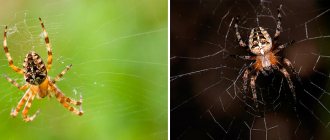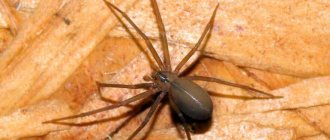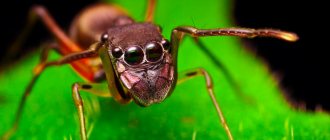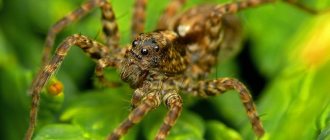Translated from Greek, arachnophobia means fear of spiders. This is one of the types of fear caused by animals (zoophobia). Arachnophobia is one of the most common phobias. Many people suffer from this disorder, which results in an excessive and uncontrollable fear of seeing or touching arachnids on the body. For some particularly sensitive arachnophobes, even the image of a spider can cause fear.
Disgust and mild fear at the sight of a spider are typical for many people, because these animals are generally unattractive. But it remains quite controlled and never completely takes over the person. Arachnophobes react to spiders inappropriately and ambiguously.
In their eyes, any spider always looks larger than it really is, more terrible and disgusting. Arachnophobes think that the arachnid will definitely try to attack them and bite them. Trying to protect themselves from, in their opinion, mortal danger, they may scream and try to kill the spider, run away or, in case of severe fright, even faint.
It becomes clear that the reason for this behavior was an attack of fear that turned into panic. If this happens every time they encounter a spider and people are unable to overcome their fear, then this means that they have developed arachnophobia.
This type of phobia can be combined with other types of insectophobia. For example, arachnophobes may simultaneously be afraid of cockroaches, ants or butterflies. At the heart of all these fears is a strong aversion to insects, which has similar root causes.
Why is arachnophobia dangerous?
Fear of insects and bugs - what is the name of the phobia?
Despite the fact that the disease at first glance can be called far-fetched and insignificant, it has the ability to cause significant harm to health and disrupt the normal routine of a person’s life.
The danger of arachnophobia:
- auto injury (during an attack, the arachnophobe does not control his behavior and can injure himself or accidentally get into a dangerous situation);
- living in a constant stressful situation, unconsciously continuously expecting a spider attack and being ready to defend yourself;
- a constant state of stress leads to a weakening of the body’s defenses and worsens the mental health of the individual;
- provokes the emergence of secondary phobias, neuroses and obsessive-compulsive disorders (for example, an abnormal need to clean the surrounding space);
- a panic attack at the sight of a spider can trigger a stroke or myocardial infarction.
What are the dangers of arachnophobia?
What is the fear of spiders (phobia) in terms of risk to health and life? Experts state that the disease is unsafe for humans. The main problem is panic without control. In this state, the individual tries to leave a dangerous situation as quickly as possible, without dismantling anything in his path. This is fraught with harm to the life or health of a person and others.
Important! Dangerous consequences include a constant state of stress. Arachnophobia becomes a part of a person’s life, along with an anxious expectation of a threat. On a subconscious level, the client is afraid of an unpleasant meeting all the time.
A phobia of spiders often leads to manic symptoms. For example, searching for accumulations of arthropods in order to destroy them, or a fanatical attitude towards cleanliness. It is most difficult for those people who live in regions with a southern climate, as well as those vacationing on hot continents. Neighborhood with insects is almost impossible to completely avoid. They often settle in dwellings and weave their webs in corners. Experts advise not to nurse your fears, but rather to start getting rid of them.
Main symptoms of arachnophobia
Fear of dolls - what is this phobia and what is it called?
In order to understand arachnophobia is a fear of what, you should identify the main symptoms of the disease. Almost every person experiences disgust, disgust, disdain or rejection of arthropods. But such feelings are not an illness; spider phobia is characterized by certain symptoms:
- unconsciously boycotting places where spiders may appear;
- the type of arthropod causes increased sweating, tachycardia, trembling of the limbs and paleness of the skin;
- panic, overwhelming fear, lethargy, or desire to run away from danger;
- feeling of unreality;
- strong desire to kill an insect.
The phobia can manifest itself either through direct contact with an insect or when looking at a lifeless spider; in advanced stages of the disease, panic appears at the sight of an image or even at the mere mention of an arthropod.
The first sign of emerging arachnophobia is the desire to kill any spider. At the next stage, an obsessive need to destroy the spider nest in the home or in the surrounding area appears. If the phobia is not treated at these stages, it can develop to alarming proportions.
Panic with arachnophobia
Causes of spider phobia
Fear of dogs - what is the name of the phobia?
Spider phobia does not arise on its own - like any illness, it has its own causes:
- hereditary or genetic phobia of spiders;
- parental behavior pattern or intimidation of a child by spiders, incorrect attitude of adults towards children's fears;
- personal negative experience, especially if a negative encounter with arthropods occurred in childhood (adults locked the child in a dark room with spiders as punishment);
- individual mental characteristics and type of nervous system (low stress resistance and psychological endurance, sensitive nervous system provoke the emergence of various types of phobias);
- a single sudden encounter with a large individual arthropod;
- features of local mentality and national behavior.
Interesting. In some countries, people do not know the concept of arachnophobia and what it is, since they eat spiders as food, and food, as we know, is not scary.
Treatment of phobia
In our country, people rarely go to doctors to treat phobias. Arachnophobia is a fairly “seasonal” fear. Most city residents encounter spiders only in the warm season; many see them exclusively in nature. Instead of looking for a solution to how to get rid of arachnophobia, many people simply try to be less in the same environment with insects, not attaching importance to their inexplicable panic. Residents of warm regions, who often have to deal with arthropods from childhood, usually become hostage to their fear.
Depending on the cause of fear and its severity, a method of treatment and combating it is selected. If you have a very obsessive fear, it is recommended to consult a psychotherapist or psychologist. The doctor will help you quickly find the source of the phobia and develop a new behavioral model when encountering an insect. Fear of cockroaches, spiders, and any insectophobia is most often treated according to the principle of situational therapy. A person is gradually prepared to meet what causes horror. To begin with, a conversation is held, points related to ignorance about the insect are explained, and knowledge about it is corrected. The last step may be a short meeting with the object of your fear. For example, you might be given a spider to hold.
Another way to overcome arachnophobia is treatment with hypnosis. It is carried out exclusively by specialists in this field, taking into account the individual picture of a person’s fear.
There are techniques that allow you to overcome insectophobia on your own. They only work in cases of mild fear that are not caused by any trauma.
It is not uncommon for former arachnophobes to adopt spiders as pets after undergoing treatment. This phenomenon is called overcompensation. For self-confidence, a person needs to constantly see his dominant position over the old source of horror.
Remember that the number of dangerous insects in civilization is quite small. At the moment, you can only find poisonous spiders on the shelf of a pet store. Fear is a natural defensive reaction of the body, but panic and unreasonable fear are signs of an advanced phobia that needs to be fought. Learn to control your emotions, use any methods to cope with fear, because harmony within yourself depends only on you!
Genetic and other prerequisites for arachnophobia
A genetic predisposition to arachnophobia does not necessarily have to manifest itself in a person. The emergence of fear is provoked by personal negative experiences of “communication” with spiders. Researchers have found that almost all children are afraid of arthropods, but as they grow up, with the correct behavior of the adult environment, the fear of spiders completely disappears. (Many former arachnophobes keep spiders as pets.) If adults show a child their fear of insects or intimidate the baby with them, then the appearance of spider phobia will not take long to occur.
For a long time, there was an opinion among scientists that the fear of spiders has been embedded in the genetic memory of mankind since ancient times, when people were forced to protect themselves from external threats. But the existence of some modern tribes that completely lack arachnophobia refutes this version.
Most spiders are harmless
Interesting fact. What saves arthropods from complete destruction is the folk superstition that killing a spider is not good. Although adherents of some religious movements believe that for destroying a spider, 40 sins are forgiven.
Experts believe that some people who have never previously suffered from a fear of spiders can consciously “grow” it if they repeatedly replay in their minds a natural human reaction to an object (a spider) suddenly appearing in their field of vision. With each such repetition, the spider will be perceived with increasing fear.
What is arachnophobia?
Few people know what the fear of spiders is called, so the concept of arachnophobia means nothing to them. This is a type of fear of insects, in other words, insectophobia. The fear of spiders has no logical origin - arthropods do not pose a threat to humans: they do not carry diseases and do not harm people.
There are several types of spiders that are dangerous to people, but they live in hard-to-reach places. Accordingly, encounters with them are extremely rare and cannot cause a phobia in people who have never been to these places and do not plan to be.
Arachnophobia
Moreover, arachnophobia is not just a fear of spiders, it is a manic fear that a person cannot cope with. Therefore, arachnophobes try not to go to places where they might encounter a spider. If such a meeting happens, the person experiences extreme stress. People experience similar feelings when meeting wild predators or during a car accident.
Is it possible to recover from arachnophobia?
Modern medicine knows how to cure arachnophobia. Along with psychotherapeutic treatment, a medicinal method of getting rid of the disease is used.
Drug treatment
Medicines for fear of spiders are used extremely rarely, only in severe advanced cases. The following medications are used to relieve the symptoms of panic attacks:
- antidepressants,
- nootropic drugs,
- tranquilizers.
Psychotherapy usually helps to cope with the disease.
Psychotherapy for spider phobia
Among the many psychotherapeutic methods for treating spider phobia, the most effective are:
- A confrontational method, during which the doctor deliberately confronts the patient with the subject of fear. In the initial stages, the patient learns to manage his fears by watching images of spiders. At the last stages of treatment, direct contact of the arachnophobe with arthropods is allowed under the supervision of a specialist. In this way, a person realizes that spiders do not pose a danger, and develops the habit of reacting evenly to their appearance in the immediate vicinity.
- “Virtual” method of combating spider phobia, developed and tested by Russian specialists. During the treatment process, the patient, using special equipment, is immersed in virtual reality, where he will have to meet and defeat a large number of arthropods. In this way, the arachnophobe acquires the ability to control his fears and gradually completely gets rid of the phobia. American psychotherapists use a similar technique, offering patients computer games, the main task of which is to defeat spiders. Spanish psychotherapists have noticed that treatment is more effective if patients touch the monitor with their fingers while playing.
Interesting fact. Fans of the computer game "Minecraft" will never become arachnophobes.
- A behavioral therapy method that involves the patient having direct contact with spiders. First with the smallest and most harmless in appearance, then all with larger individuals (up to the tarantula spider). Experts who use this method believe that avoiding the subject of fear strengthens the phobia, and frequent direct contact helps to overcome fears.
- Overcompensation technology (can be used as part of behavioral therapy, or as an independent method of treatment). The point is that the arachnophobe deliberately keeps an arachnid in his home, cares for it, feeds it, and creates favorable conditions for existence. This method allows the patient not only to overcome his fears, but also to feel more complete.
"Communication" with a spider
- The graphic method of treatment is that the patient is asked to draw an object of fear, that is, a spider, then destroy it (tear, burn or drown the drawing, sketch the image). As a rule, huge arachnid monsters appear in the first drawings, but each time the arthropods become smaller and cuter. The phobia is considered defeated if the patient begins to draw kind and cute spiders and refuses to destroy them.
- A method of deep psychoanalysis, which allows you to transfer a problem from the depths of the subconscious to the surface of consciousness and fight with suitable methods.
- Hypnosis sessions also help to cope with arachnophobia in a short time.
Important! Psychotherapists select treatment for each patient personally, taking into account the degree of the disease and its individual characteristics.
How to get rid of arachnophobia yourself
The initial stages of the disease or mild degrees of arachnophobia can be cured on your own. Psychotherapists believe that traditional methods of dealing with any phobias are also relevant for fear of spiders.
How to overcome arachnophobia yourself:
- Stop discussing your fears in detail with many strangers. It's better to trust a specialist. In addition, repeated re-experiencing of fear aggravates the situation.
- Learn meditation or other relaxation methods.
- Realize responsibility for your fear, overcome it and force yourself to touch the spider.
- Study the literature on this topic, learn about the habits, lifestyle and structure of arthropods. Accept that spiders are not dangerous.
- Do several exercises aimed at eliminating phobias.
Causes of arachnophobia
Many years of research have shown that people susceptible to arachnophobia are not aware of the irrational nature of their fears. Previously, most scientists believed that arachnophobes recognized the irrationality of their fears and were able to maintain some control over their fears. But it was later discovered that all arachnophobes are not fully aware of the nature of their fear, both in the presence of a spider and without it.
Studies conducted among children showed that although all the children tested were previously afraid of arthropods, their arachnophobia appeared as a result of a certain conditioning event.
From birth to adolescence, children focus their behavior on their parents and significant adults. Therefore, if one of the adults is susceptible to arachnophobia and considers arthropods dangerous and tries to avoid them, then there is a possibility that the child will experience the same fear, which will then control him. In such children, just looking at arthropods increases the pulse and heart rate. This theory can be confirmed by the observation that arachnophobia mainly spreads in certain areas.
There is also an opinion that the cause of arachnophobia may be the excessive danger of certain types of spiders, which contributed to the formation of such a phobia during the evolutionary development of an individual.
However, today there are a sufficient number of uncivilized peoples in whom such a phenomenon as arachnophobia is practically unknown. They even eat some varieties of arachnids. And in other cultures, arachnids are even worshiped.
Manifestations of arachnophobia should be differentiated from simple rejection of arachnids. Many consider them disgusting and disgusting, they try to shake them off, people are disgusted by touching the web, but this is just hostility, and not manifestations of arochnophobia.
Many physiologists and psychologists often explain the causes of arachnophobia by a significant difference in the structure of arachnids from humans. It is believed that the more different a living creature is from a person, the stronger the fear of it will be. However, this is not entirely true. There are many living organisms in the world that are significantly different from people, for example, jellyfish, but people do not experience panic fear of them.
The causes of arachnophobia are considered to be the suddenness, unpredictability of movements and the swiftness of spiders. Those. a person can notice them only when they are already in close proximity to his body. Also, the combination of a small body along with large legs and their number causes feelings of fear. The danger due to the poisonousness of spiders may also be one of the reasons for the development of arachnophobia. There is also a hypothesis that during the plague epidemic, arachnids were considered carriers of infection.
Arachnophobia and its causes are the filling of blue screens with films, the main genres of which are thrillers and horrors, where the acting “villains” are huge arachnids.
Modern biologists have proven that arachnids are a fairly ancient species of living organisms, which during the process of their evolution did not undergo any significant changes in size towards increase. On the contrary, in prehistoric times arthropods were much larger and much more dangerous. Therefore, today there are completely no facts on the basis of which it could be argued that in our time there could be an ancestor of giant-sized arachnids.
For the most part, spiders cause hostility and disgust in almost all people. Spiders today are saved from mass destruction by human superstitions, which consist in the fact that killing arachnids is considered a bad omen. Although in some beliefs it is believed that killing a spider removes 40 sins.
Exercises to treat arachnophobia
Dissociations
- Imagine that the spider is further and further from the arachnophobe: first at arm's length, then in the next room, on the street, in another city or in space. Then look at the insect through imaginary binoculars or a telescope to see that the arthropod means nothing.
- Change the time of action mentally. To begin, fix a state of peace and tranquility in your mind. At the moment of an attack of arachnophobia, try to remember this feeling and imagine that such a moment has come right now.
- Change reality. In your imagination, paint the world around you with all sorts of (possibly unusual) colors, and “repaint” the spider in a gray, nondescript color. Imagine all the surrounding objects as large and significant, and the arthropod as small. Then imagine that the insect shrinks and disappears completely.
Interesting fact. Some psychotherapists recommend going to a country where spiders are a delicacy, and try to eat your fear (if possible).
Eat your fear
Art therapy
This method is effective for both treating adults and children:
- Make a detailed figurine of a spider from plasticine. Moreover, make it as similar as possible to the object of fear, both in color and size.
- For some time, examine the sculpture in detail and mentally connect your fear with it.
- Kill your fear (tear off your head, crush it, etc.).
- The sculpture can be replaced with a drawing, but, according to experts, destroying the plasticine figurine is more effective in eliminating fear.
Plasticine spider
Many people underestimate arachnophobia and consider it something insignificant. Without timely treatment, this disease leads to chronic stress, mental disorders, and can cause heart attack and stroke. At the initial stage of the disease, 4-5 sessions with a psychotherapist permanently cure spider phobia. An advanced phobia requires long-term and labor-intensive treatment. Arachnophobia, like any other disease, does not tolerate neglect and without proper attention takes on threatening forms.











